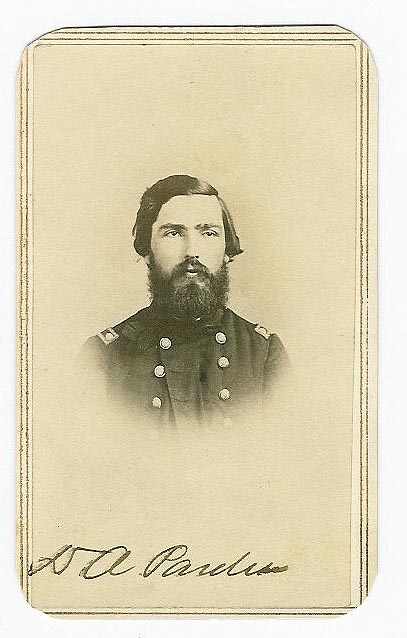Last updated: October 28, 2020
Article
Colonel Don Pardee of the 42 Ohio Volunteer Infantry (Part 1)

Ohio Historical Society
On May 1, 1863 the Union campaign to seize the city of Vicksburg was fully underway. General Ulysses S. Grant ordered an attack at Port Gibson well south of his intended target. The goal was to secure the port, land troops, and advance north to Vicksburg. The 42nd Ohio Volunteer Infantry was in the thick of the fight. Lieutenant Colonel Don Pardee was in command of the regiment, leading his troops on several assaults on the Confederate defenses. There came a lull in the fighting where Colonel Pardee stopped to discuss his options with another Union commander. While the two spoke, a Confederate musket ball streaked inches between them. The Union commander flinched, then awkwardly backed away. Pardee never moved. He had no fear on the battlefield, a quality that many of his fellow officers did not possess.
Don Albert Pardee was born March 29, 1837 in Wadsworth, Ohio. In 1824 his father, Aaron, traveled from Connecticut to Ohio to clear land his family had purchased. He eventually built a large working farm that became quite successful as the years passed. Aaron studied law and developed a large practice that gave him enough influence to secure fifteen-year-old Don an appointment to the U.S. Naval Academy. As a midshipman Pardee excelled in his studies, rising to second in his class. Among the midshipman was George Dewey, who would later command the ships that fought against Spain in the Spanish-American War of 1898.

Hiram College Archives
Pardee became proficient in mathematics, artillery, and infantry. He had two tours of duty on the Preble, a sloop of war that sailed the eastern coast of the United States. Don was on his way to a promising naval career when his father summoned him home to help with the law practice. In 1859, after two years of study he began a practice in Medina County, Ohio. Just before the beginning of the Civil War, Pardee married Julia Hard, a local girl from Wadsworth. The bride and groom knew each other well when they were classmates at the Wadsworth district school.
In April 1861 the Civil War began. Pardee did not initially enlist due to Julia being in poor health. The Union Navy offered to reinstate him with his class but Don stayed home to care for his wife. A combination of the Southern victory at Bull Run and Julia recovering from her illness prompted the former midshipman to accept a commission as Major of the 44th Ohio Volunteer Infantry (OVI). After reporting to Camp Chase, Pardee became sought after by Colonel James A. Garfield, commander of the 42nd OVI. Garfield needed an officer with a strong military background and arranged for Pardee’s transfer to the 42nd. Pardee reported for duty and helped turn raw recruits into soldiers. One would later remark that the Major was strict in his discipline, often barking orders that made the boys jump. Frank Mason, who wrote the regimental history of the 42nd said, “His military education had made him an iron disciplinarian, but behind and with that was the strength and readiness in emergencies, that tenacity and power of command, which wins from soldiers a respect which no lighter attributes can inspire.”
In the fall of 1861, Pardee heard a ruckus on the campgrounds. He ordered a corporal from the 42nd and a detail of three privates to take care of the disturbance and arrest anyone if necessary. The guards reported back to the Major, advising there was a company of new recruits that had been out drinking. The rowdy soldiers waved their muskets at the small detail causing them to flee the scene. Pardee took the detail back to the drunken mob and showed his physical strength by disarming a number of the revelers. The new recruits suddenly became quiet. Major Pardee then ordered his detail to disarm the rest and march them to the guardhouse. All in a day’s work.
With Louisa secure, Colonel Garfield quickly planned an assault of the Rebel position. He moved his brigade directly south to Paintsville where he engaged Confederate General Marshall. Garfield aggressively attacked at three separate positions causing the Confederates to retreat further south beyond Middle Creek. The Union brigade pursued, finding Marshall’s men in the hills just beyond Middle Creek. In early January1862, Major Pardee led the assault, climbing the hills to dislodge the well-entrenched Confederates. The fighting raged throughout the day until darkness forced Pardee to lead his men back down the hills.
During the night Marshall decided to burn his supplies and retreat further south into Virginia. A harsh winter delayed any further advance of the Union army. In March, Pardee led 500 men on a surprise assault at Pound Gap near the Virginia border. The Confederates were caught eating breakfast and fled the field, abandoning any hopes of occupying eastern Kentucky. Pardee received a promotion to Lieutenant Colonel.
Several months later the 42nd was attached to the 7th Division under General George Morgan for the Cumberland Gap Campaign. Pardee led a small force on a night raid to clear Rogers Gap from where the major assault would be launched. The maneuver went as planned, allowing the division to form lines for the attack. The Confederates pulled back, abandoning Cumberland Gap and moving south into Tennessee.
(Check back soon for Part II!)
Written by Scott Longert, Retired Park Guide, James A. Garfield National Historic Site, March 2013 for the Garfield Observer.
